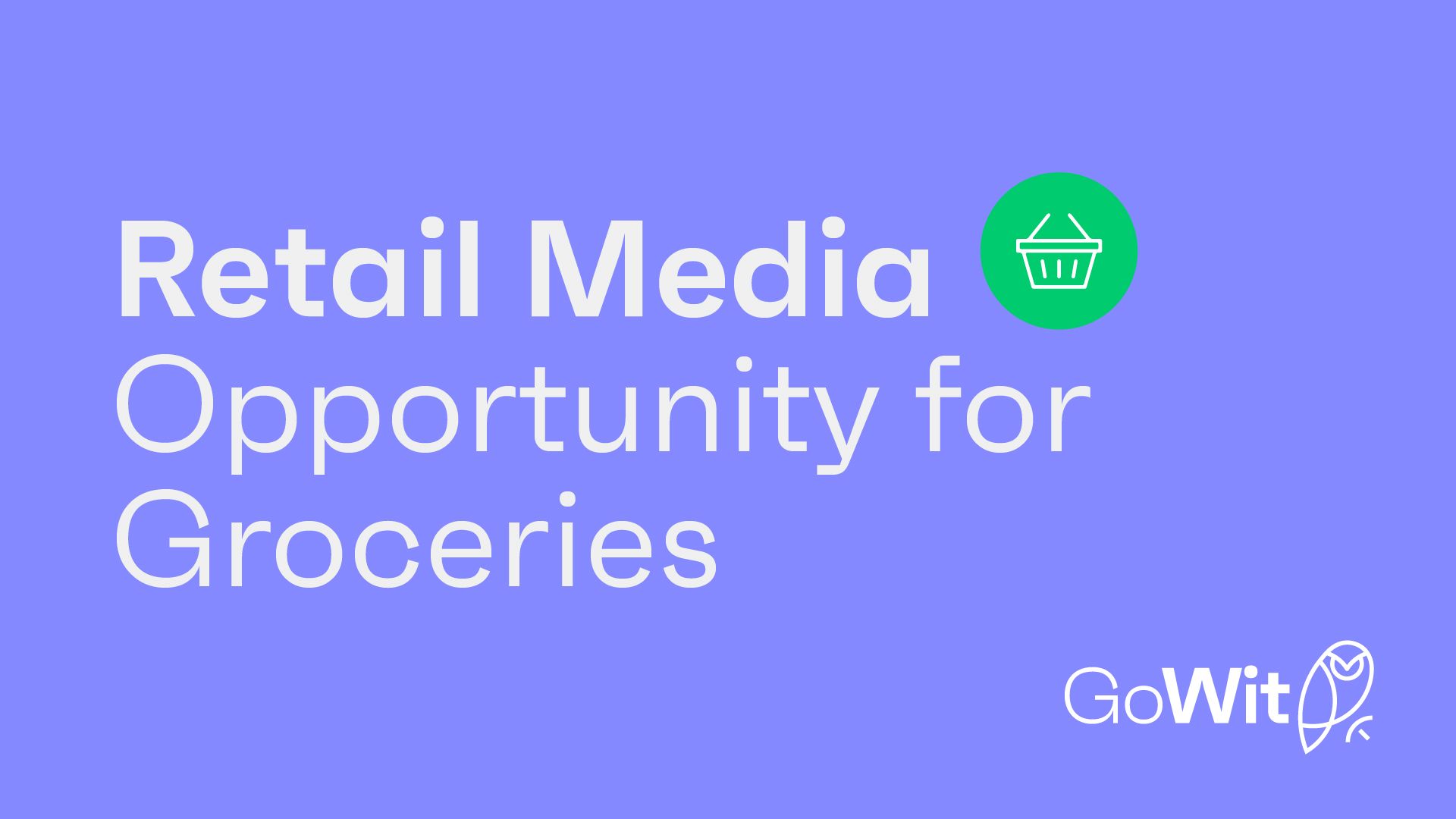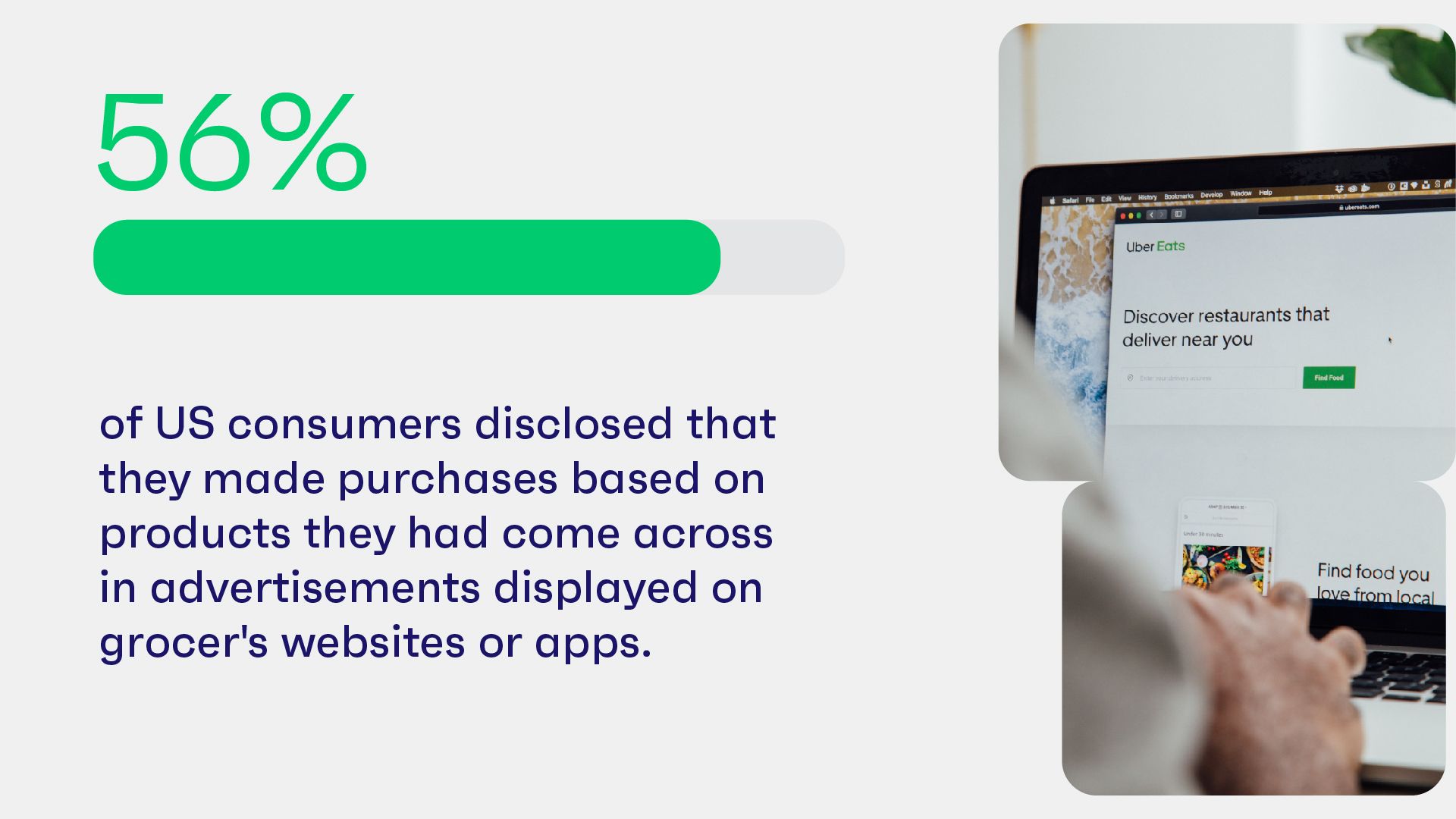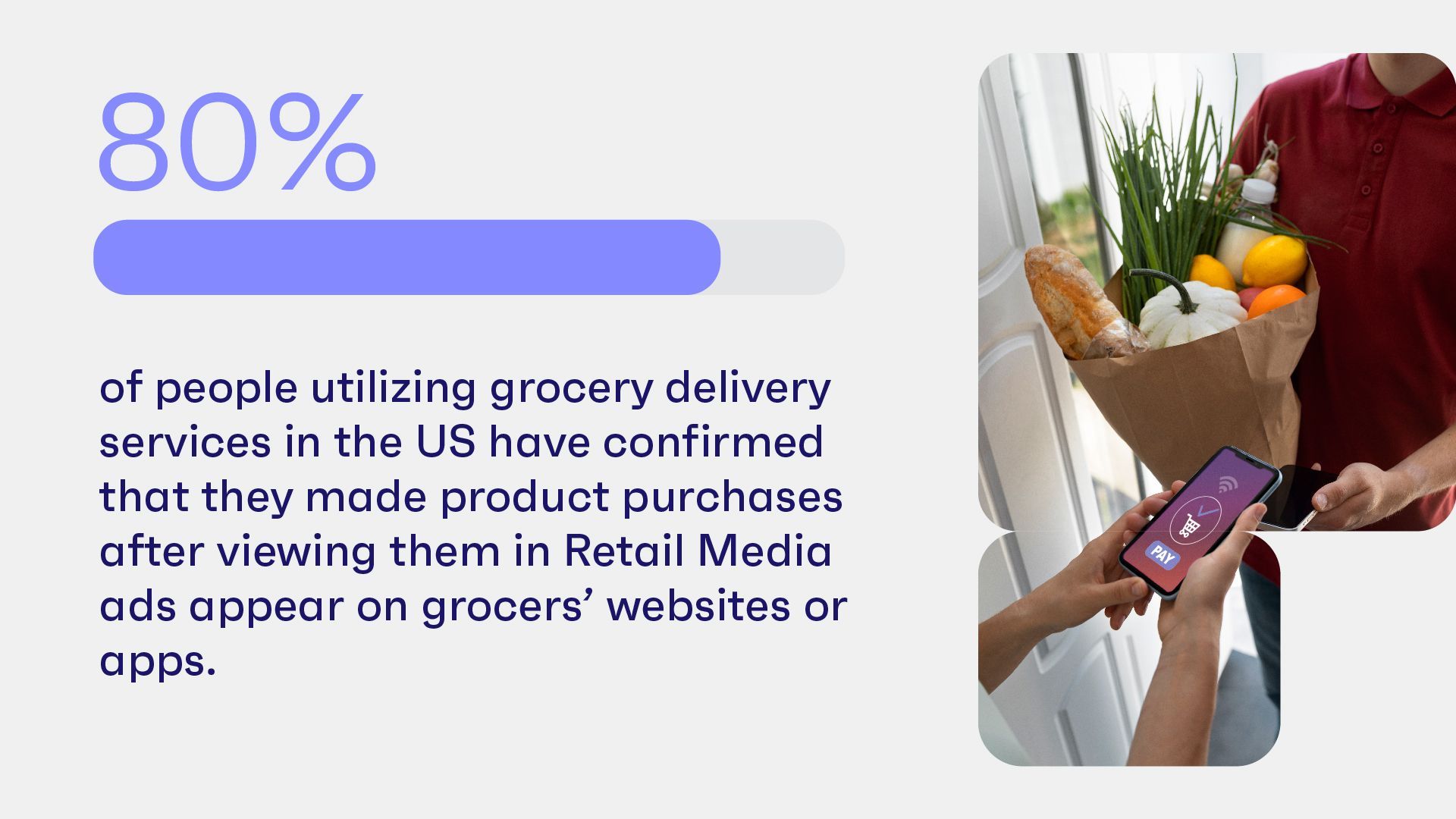Retail Media Opportunity for Groceries
Retail Media
.
8 min read
80% of individuals utilizing grocery delivery services in the US have confirmed that they made purchases of products featured in Retail Media ads.

“Groceries are actively pursuing opportunities to capitalize on the rising potential of Retail Media.”
The latest analysis from WARC Media projects a remarkable 10.1% surge in global spending on Retail Media, reaching an impressive $122 billion in 2023. This staggering growth positions Retail Media as the fastest-growing media channel, outpacing even the rapid evolution of e-commerce, a pace unpredicted in the grocery sector.
Groceries are keen to increase up their efforts and provide more interesting content, but they still have work to do to satisfy their suppliers and keep up with this rapid Retail Media innovation. The Retail Media possibility for supermarkets and food retailers has become a significant source of income, in particular, retailers in the food industry have cited the great increase in high-margin Retail Media revenue.
“In 2023, every CPG brand will have Retail Media included in their budget, many for the first time. This is the year everyone, from an advertiser standpoint, jumps into the market.”
Jordan Berke , founder of Tomorrow Retail Consulting
Contextual Targeting in Grocery Aisles
This year, advertisers are primed to craft attention-grabbing content and establish stronger customer loyalty through personalized and contextually targeted advertisements. Retail Media platforms offer a wealth of contextual targeting choices for groceries, presenting a potent strategy to connect with individuals who are active in the market looking for products. In this regard, contextual targeting empowers advertisers to display ads to those most likely interested, driven by the relevance of the content customers are currently engaging with.
Data is the biggest treasure
It is a fact that brands are struggling to find their way in a world without cookies and are in need of the insights that grocery stores data can offer. So, data is crucial for both brands and groceries. Groceries may access valuable data in a variety of ways in Retail Media platforms, including loyalty programs, in-store consumer data, foot traffic data, online purchasing data, and more. In order to create effective Retail Media partnerships, groceries need to take full use of all of these data sources all together.
Direct Customer Connection at the Point of Purchase
Retail Media platforms engage shoppers during their in-store journeys, creating a highly impactful environment, particularly in the grocery sector.
In-store retail media services seamlessly integrate with omnichannel advancements like ordering kiosks and self-checkout terminals, enhancing the overall shopping experience. Grocers are embracing innovation by incorporating TV screens into aisles and service counters. These screens enable shoppers to access branded content while strolling or awaiting their orders, fostering engagement and interaction.
As we mentioned in our previous articles, Cooler Screens, an innovator that introduces advertising and product information through digital cooler doors, concurrently gathering valuable shopper analytics. Their ambitious expansion plan involves moving beyond the confines of refrigerated aisles, extending to encompass store endcaps, checkout lane coolers, pharmacy screens, and various other zones. Backed by major grocery stores such as Kroger and Giant Eagle, Cooler Screens aspires to quadruple the in-store screen count, targeting a remarkable total of 40,000 screens within the forthcoming 12 to 18 months.
Another example is Instacart, which, earlier this year, augmented its repertoire by introducing Display Ad functionality specifically tailored for Consumer Packaged Goods (CPGs). This addition complements the company’s existing array of Sponsored Product offerings.
“Display ads enable national CPG brands to promote engaging, targeted, creative banners to raise awareness and consolidation of products, helping to drive bigger baskets for grocers,” Instacart says.
When it comes to consumer decisions, Mood Media explains that engaging digital content has the second-highest influence on shoppers. The use of storytelling, messaging, animation, and brief video clips that deliver interesting content may therefore require grocers to collaborate with competent Retail Media ad partners.
Join to get free updates every week
Grocery Retail Media Report Insights
In order to see the impact of Retail Media ads on consumer decisions, we draw insights from a Dabbl study that delves into consumers’ grocery shopping habits and their interaction with grocers’ websites and applications. The research uncovered that an impressive majority, 77% of consumers, utilize grocers’ websites or apps to find deals. Additionally, 54%, engage with grocers’ digital platforms to conveniently place online orders for products.
When we look at the impact of groceries’ advertisements on consumer behavior, a substantial 56% of US consumers disclosed that they made purchases based on products they had come across in advertisements displayed on grocer’s websites or apps. Notably, these purchases extended to both online transactions and later in-store acquisitions.

Close to half of consumers, accounting for 48%, opted to make purchases in-store after encountering a Retail Media advertised product. Meanwhile, 41% of respondents indicated that they chose to acquire the advertised products through online platforms. Furthermore, a notable 11% shared their preference for a dual approach, purchasing the Retail Media advertised products both online and in-store.

Retail Media has a great impact on grocery delivery users, a substantial 80% of individuals utilizing grocery delivery services in the US have confirmed that they made purchases of products featured in Retail Media ads.

Personalization is vital for digital advertising
Strategically placing relevant advertisements at the point of purchase holds the potential to guide customers towards better buying decisions. This practice contributes to an overall improved customer experience. Here, relevant ads serve as a helpful reminder for items customers may require, particularly in the context of grocery shopping.
It’s also important for groceries to remain mindful of customers’ sensitivity to ads. More and more shoppers seek transparency and authenticity in their interactions, shunning content that conceals its promotional nature. Establishing a genuine connection with customers is crucial. So, personalized ads emerge as a potent tool to capture customer attention and drive engagement, reflecting a commitment to their individual preferences and needs.
Taking advantage of Retail Media platforms, groceries can leverage first-party data to display products that customers are likely to be interested in, enhancing personalization in their ads. With first-party data, groceries may better understand consumer purchasing patterns by using the information gathered from online ads, which will help their suppliers run their businesses more efficiently.
From another standpoint, groceries need to serve advertisements that benefit the consumer, such as alerting them to special offers on products that complement those they’ve recently added to their carts or giving them additional information that helps them choose between two similar items which calls for advertisements that are contextually relevant.
New Revenue Channel for Groceries
In a dynamic grocery sector marked by innovation, it’s true that Retail Media emerges as a golden opportunity for augmenting revenue streams and bolstering profit margins. Notably, for grocery stores, the most important advantage of Retail Media networks lies in their capacity to provide new revenue channels. The average profit margins for in-store Retail Media are thought to be more than 70%, according to Forrester. Retailers have an enormous amount of opportunity to introduce digital advertising inside grocery stores, installing smart carts available to customers and displaying video material on display screens that can be seen across the store’s sections, bringing in-store retail media into the mainstream.
In-store Retail Media serves as a valuable resource for shoppers, providing them with essential information such as nutritional specifics and allergy alerts in a user-friendly format, far more accessible than a small text on product packaging. A Mood Media survey found that 56% of UK consumers value inspirational, educational, and atmospheric content on in-store digital screens.
Digitization in Grocery Stores
The digitization of Retail Media is spreading throughout grocery store aisles and impacting customers at the point of sale. This is why Tesco supermarkets in the UK has 500 screens broadcasting advertisements in its stores as part of its Retail Media strategies. Tesco has revealed plans to add 150 additional stores to its chain of in-store digital screens in order to display more enticing animations and images. Additionally, Kroger is growing its in-store Retail Media to several hundred outlets by adding more digital signage.
Grocers’ Entry into In-Store Digital Advertising
The present moment holds immense promise for grocers to embrace the trend of in-store digital ads. However, it’s crucial to acknowledge the prevailing competition within the realm of in-store Retail Media, spanning both the supermarket domain and beyond. Esteemed industry players like Bestbuy, Tesco, Macy’s, and Kroger have already established their Retail Media advertising infrastructure, alongside numerous medium-sized grocery chains. There exists a distinctive advantage for regional grocery chains that are currently in the process of setting up their Retail Media platforms, a strategic second-mover edge that positions them well in this evolving landscape.
Finding the ideal Retail Media partner who comprehends the advertising media side and can supervise the technical components of an ad platform is essential for many supermarkets and groceries to achieve effective implementation. Groceries need to seek out a qualified AdTech team that is capable of managing ad inventory, setting up and maintaining digital infrastructure for delivering ads, ensuring security, adhering to data privacy laws, and providing good customer service.
Sources:
Cohen, W. (2021, July 29). Grocery Retail Media Report: How Consumers Feel About Ads on Their Grocers’ Websites and Apps. Dabbl. https://brands.getdabbl.com/blog/grocery-retail-media-advertising-report/
Huang, C. (n.d.). Retail media to be the fastest-growing channel in 2023, reaching $122bn | WARC. Www.warc.com. Retrieved August 10, 2023, from https://www.warc.com/content/paywall/article/warc-curated-datapoints/retail-media-to-be-the-fastest-growing-channel-in-2023-reaching-122bn/en-GB/148817?
Lalley, H. (2023, April 3). Retail media comes of age. Winsight Grocery Business. https://www.winsightgrocerybusiness.com/retailers/retail-media-comes-age
The Friday Checkout: As retail media moves into stores, grocers need to proceed with caution. (2023, June 9). Grocery Dive. https://www.grocerydive.com/news/retail-media-digital-in-stores-grocers-need-to-pro/652551/
What grocery chains need to know before implementing in-store retail media. (2023, July 17). Supermarket News. https://www.supermarketnews.com/technology/what-grocery-chains-need-know-implementing-store-retail-media
What the rise of in-store retail media networks means for grocers | Grocery Trader. (2023, June 8). https://grocerytrader.co.uk/what-the-rise-of-in-store-retail-media-networks-means-for-grocers/
What’s ahead for retail media in 2023? (n.d.). Grocery Dive. Retrieved August 10, 2023, from https://www.grocerydive.com/news/whats-ahead-for-retail-media-grocery-in-2023/640705/
Share
